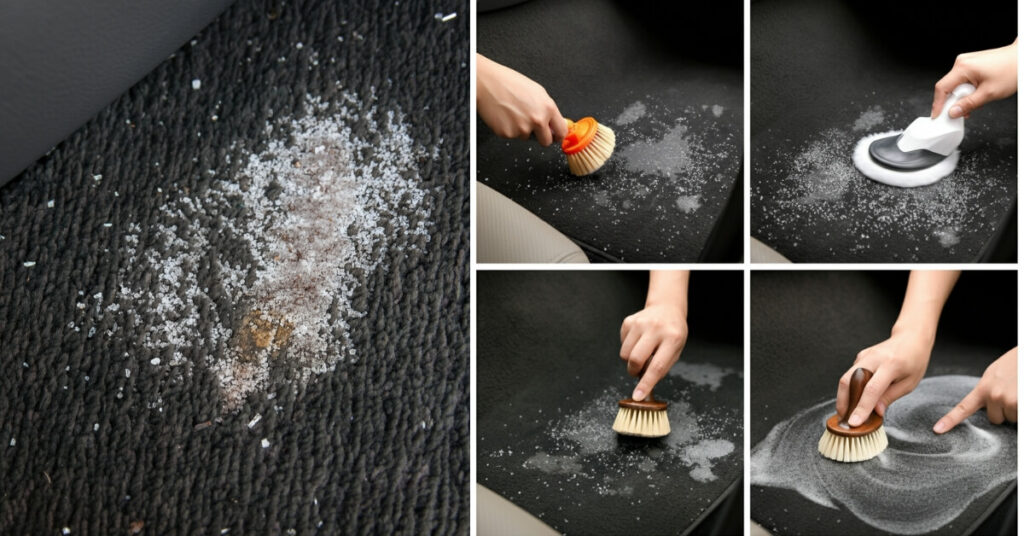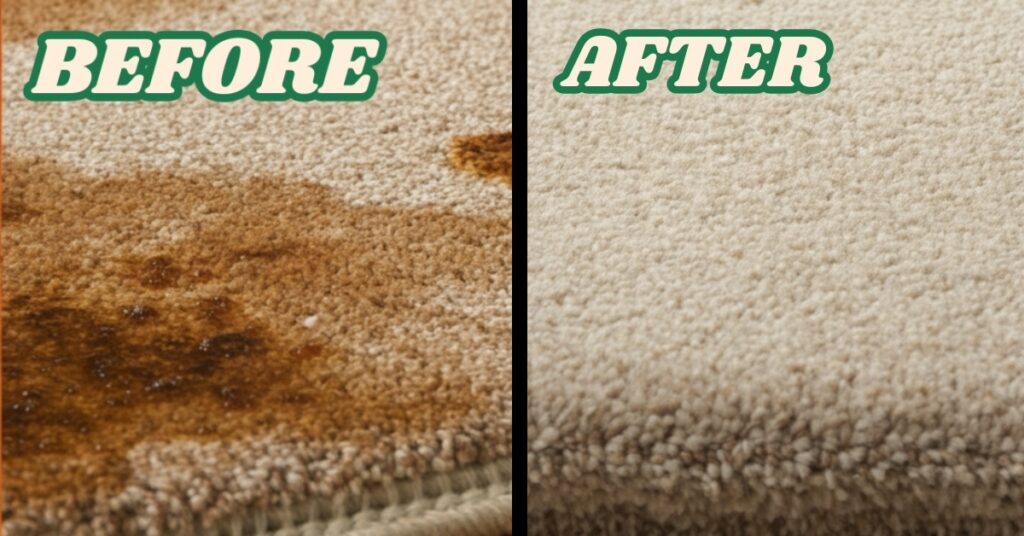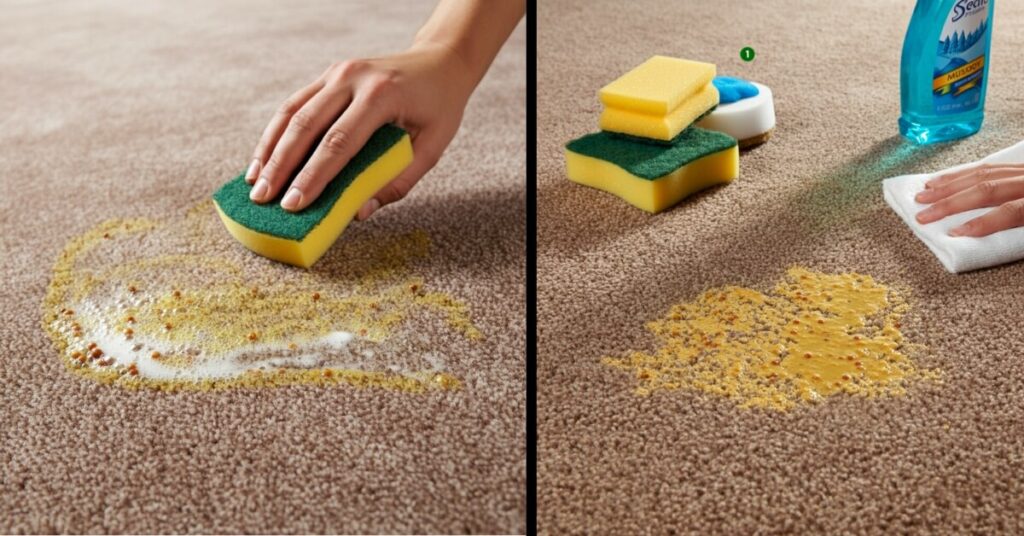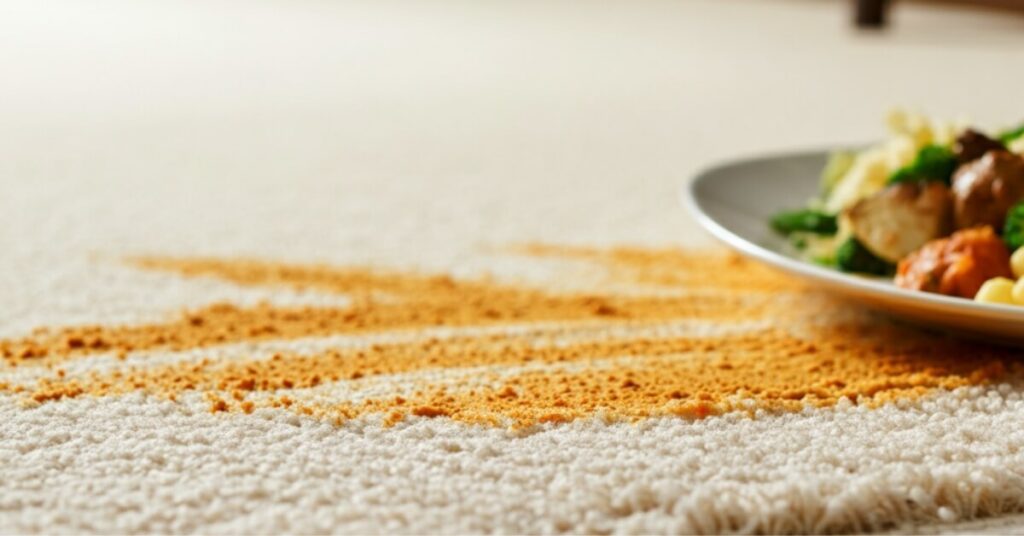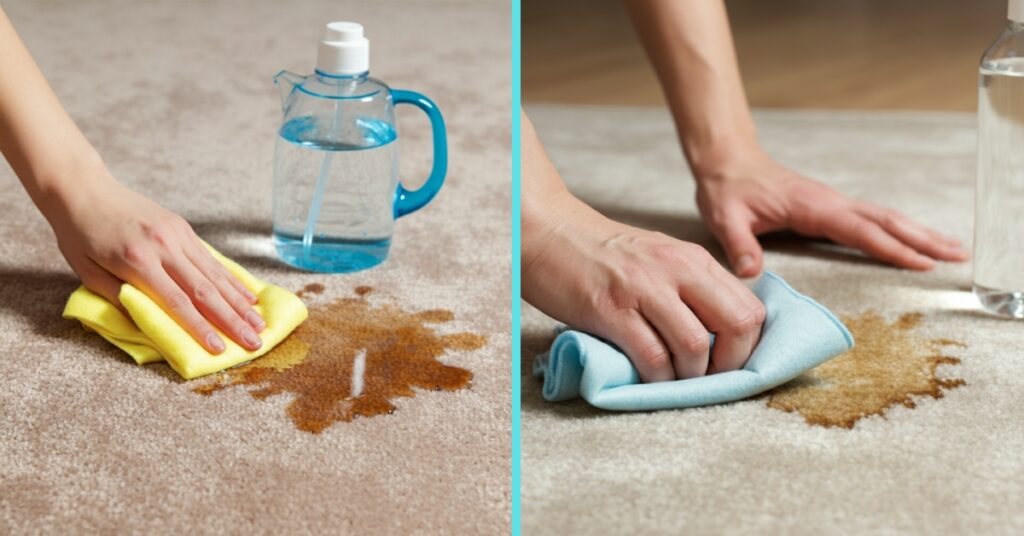As an Amazon Associate, I earn from qualifying purchases.
Salt can be your best friend in winter months. But for your car’s carpet, it can quickly become a nightmare. That chalky whiteness known as salt stains not only looks bad, but can actively damage the fibers of your car carpet. This damage may lead to permanent destruction and even create stubborn smells. That’s why it’s important to remove salt stains from car carpet as soon as they appear to avoid long-term damage.
If you’ve been asking yourself, “How do I remove salt stains from car carpet?”, you’ve come to the right spot. Bringing back your car’s interior is easy with some common household items and a bit of effort. Whether you detail regularly or only the season demands it, this guide is tailored for anyone. Following this guide will help effectively tackle salt stain removal and allow you to maintain a fresh, spotless car, prepared for any season.
Contents Overview
Why Salt Stains Appear on Car Carpets
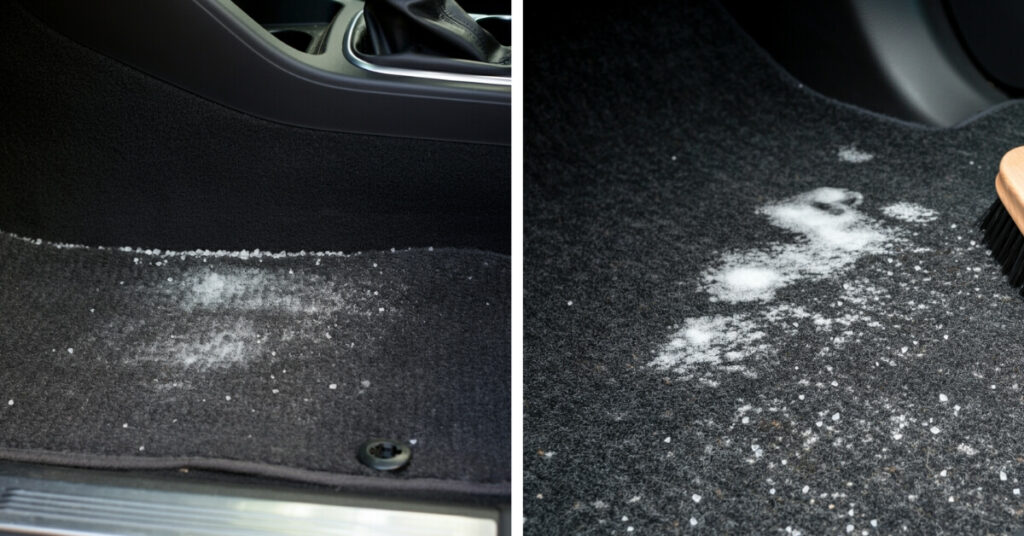
During the winter months, road crews spread salt on roads to avoid icy conditions. While the effort is noble, salt and liquid from snow or slush is often tracked into cars on shoes and boots.
Once inside, the moisture evaporates which leaves behind stubborn white residue – the remains of salt. These stains can be found on the carpet and the floor mats, particularly fabric ones as opposed to rubber.Eventually, these deposits accumulate and become corrosive, damaging the fibers of your car’s carpet. The longer these stains remain untreated, the greater the effort required to clean them.
If left ignored, the salt can result in discoloration, weakening of the carpet, and/or unpleasant smells inside the vehicle, especially when combined with summer humidity or leftover winter moisture. These reasons indicate the importance of regular cleaning, even when there are no visible stains.
The Science of Salt Stains
Salt is hygroscopic, which means it attracts moisture. In areas with heavy snowfall, salt stubbornly leaves behind hard crystalline patches that are both a chore to remove and to prevent. Over time, the salt crystals not only stain the carpet but also damage its structural integrity, which affects how your home looks and the lifespan of the furnishings.
What You Need for Salt Stain Removal
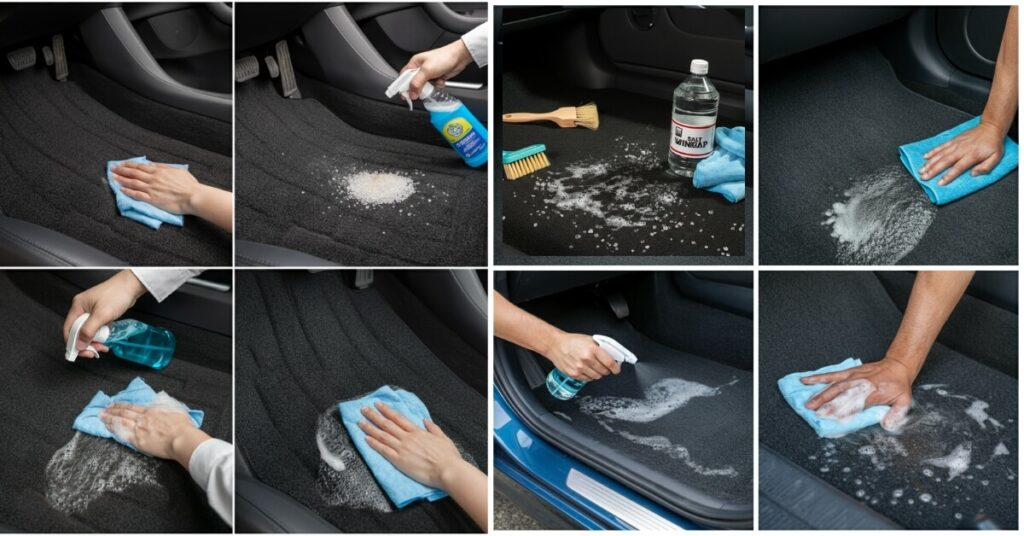
Luckily, cleaning salt stains doesn’t require fancy tools or specialty products. You can clean them easily with items you likely already have at home or with a few affordable purchases. Here’s what you’ll need:
You won’t require fancy tools or specialty products to clean carpet stains. Instead, you would most likely have everything at home or only need to make a few inexpensive purchases.
The following items will help you clean the salt stains efficiently:
- Vacuum cleaner: An essential tool to remove the loose dirt and salt crystals pre-cleaning. Best results will be achieved if you use a vacuum with a brush and hose, as it allows you to reach all corners and every nook and cranny.
- White vinegar: Breaks down salt deposits without damaging the fabric. Achieving the best results is possible when using distilled white vinegar. It is clear and contains the acetic acid needed to dissolve minerals left behind by salt.
- Warm water: Required to dilute vinegar, and especially important for vinegar to be effective against stubborn stains.
- Spray bottle or small bowl: Both are effective for applying the cleaning solution. The spray bottle permits application of the mixture at the site needed, while sprouting bowls are good for soaking the clothes.
- Stiff-bristle brush or old toothbrush: These two are important when it comes to cleaning salt deposits within the fibers of the carpets. When choosing a brush, ensure it is not too harsh to avoid damaging the carpets.
- Clean Microfiber Towels: Excellent for blotting and damp drying the affected region. Since microfiber absorbs water efficiently, it will not leave any lint behind.
- Wet/Dry Vacuum (Optional): These are perfect for removing excess moisture as well as dirt from the carpet, especially after rinsing or dealing with larger vehicles.
- Sodium Bicarbonate (Optional): This can be used as a deodorizer in order to keep the car smelling fresh. Moreover, it helps neutralize smells that vinegar alone might overlook.
If the salt build-up is especially stubborn, one might want to consider using an upholstery cleaner or an enzyme-based stain remover.
Step-by-Step Guide to Removing Salt Stains from Car Carpet
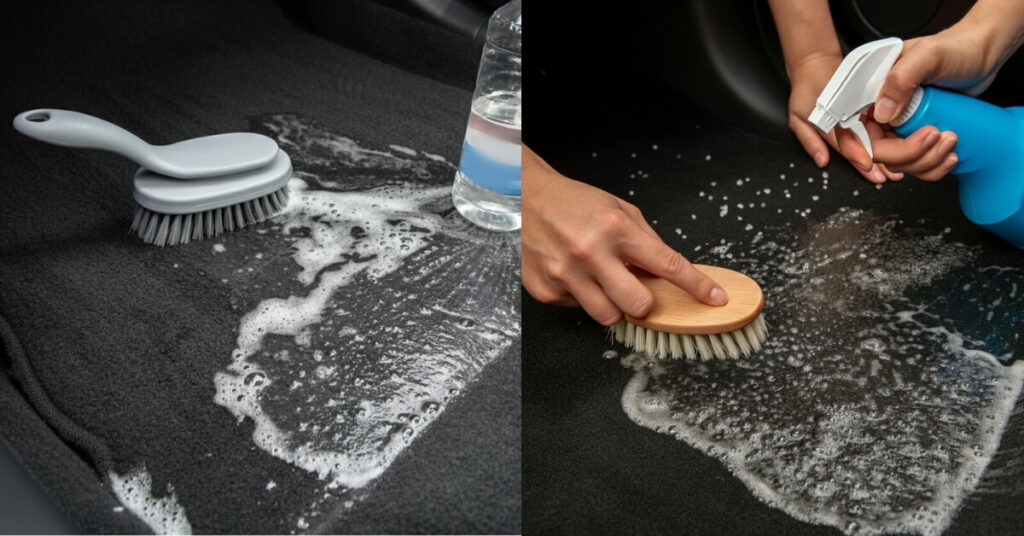
Follow these straightforward steps to remove salt stains effectively without damaging your car’s interior. Remember to work in a well-ventilated area — open your car doors or windows if possible to ensure plenty of airflow.
Step 1: Vacuum the Carpet
Begin by accomplishing a thorough vacuum of the car’s carpet. This will ensure that any loose debris, dirt, and salt crystals are taken away before the deep cleaning begins. When rubbing the damaged area, make sure to focus on the area surrounding the carpet stains.
Make sure to check the seams and edges since salt usually accumulates at the carpet door seam or underneath the seats. To achieve the best results, make sure to take slow overlapping passes.
Step 2: Prepare Your Cleaning Solution
White vinegar is very effective at breaking down salt deposits, meaning it’s perfect for removing salt stains. To prepare your solution, mix equal parts vinegar and warm water in a bowl or spray bottle. 1 cup of vinegar and 1 cup of water works perfectly. To soften the scent, vinegar and water solution can be infused with a single drop of essential oil like lemon or lavender. Just don’t overdo it.
Step 3: Apply the Solution
Spray or apply the vinegar and water mixture directly on the salt-stained areas, soaking the fibers well so they can release the salt residue trapped deep inside. Without a spray bottle, you can soak a clean cloth in the solution and dab it onto the stain. Let it sit for two to three minutes so the vinegar can dissolve the minerals before scrubbing.
Pro Tip: For extra-stubborn stains, lay a damp, vinegar-soaked towel over the spot and let it sit for 5–10 minutes. This prolonged contact softens and loosens dried salt patches for easier removal.
Step 4: Scrub the Stain
With a stiff-bristle brush or an old toothbrush, gently scrub the stained portion of the carpet. Salt deposits are often embedded deep within the fibers, so work in small circular motions to lift them out. Avoid aggressive scrubbing, as it may damage the delicate carpet.
Work gently, breaking the salt bonds so that they can be blotted out with ease. For greater ease, fabric floor mats may be cleaned outside the car—this not only ensures thorough cleaning but also prevents solution splashes on the trim or seats.
Step 5: Blot the Area
Using a clean towel or microfiber cloth, soak up the dissolved salt and remaining cleaning solution by blotting the area. Firmly but gently press the cloth, lifting moisture instead of rubbing it around. To improve absorption, rotate or replace your towel as required.
If the stain remains, go back to steps three and four until complete removal is achieved. Remember, for tough winter stains, being patient and thorough are your greatest allies.
Step 6: Optional Rinse
Spraying the cleaned area with plain warm water and blotting can remove any remaining vinegar smell or residue. This step is optional but rinsing the area adds a more professional touch, especially in smaller cars where odors tend to build up. For a professional finish, use your wet/dry vacuum to extract excess moisture after rinsing.
Step 7: Dry the Carpet
Drying the carpet properly is just as crucial as cleaning it. Use a clean, dry towel to absorb the water, then leave the doors ajar or place a fan near the vehicle to expedite the drying process.
To prevent the growth of mold or mildew— which can lead to unpleasant, long-lasting odors and health issues— refrain from driving until the carpet is fully dry. In colder regions, using a portable space heater or parking in a heated garage can help reduce drying time.
Bonus Tip: Sprinkle Baking Soda for Freshness. Once your carpet is completely dry, sprinkle baking soda over the area to neutralize any lingering odors and absorb excess moisture. Allow it to sit overnight, then vacuum it up for a clean, fresh-smelling car interior that’s truly winter-ready.
Real-Life Examples & Troubleshooting
- In the case where there is a lot of salt, first gently scrape the brittle thick layer with a blunt knife before spraying the vinegar solution.
- For those who use pedals and seats, salt residue often gets missed. Try using a portable vacuum cleaner paired with a narrow brush to remove stubborn residue.
- For stubborn discoloration, repeat rounds with the cleaning solution or try adding a drop of mild dish soap to the mix.
How to Prevent Salt Stains in the Future

Cleaning salt stains can be time-consuming, so it’s always a good idea to take preventive measures to keep them from forming in the first place. Here are some simple strategies to protect your car carpet during the winter:
1. Invest in All-Weather Floor Mats
Replace standard mats with rubber and plastic mats, which are designed to prevent snow, salt, and dirt. They are simple to maintain and provide protection between your shoes and the carpet.
2. Tap Your Shoes Before Entering
Get into the habit of knocking excess snow and salt off your shoes or boots before stepping into your car. This small, quick step can make a big difference over the course of one winter.
3. Vacuum Regularly During Winter Months
In winter, frequent vacuuming of mats helps your car’s interior as well as prevents salt accumulation, which can become difficult to deal with later on. If you travel on salted roads often, try to clean out your floor mats every week.
4. Use Protective Carpeting Spray
Automotive fabric protectors are specially designed to add a layer of defense against moisture, making the issue of long-term stains incredibly easy to deal with. Stain-specific automotive sprays are recommended for best results.
5. Clean Stains Immediately
The quicker you address salt stains, the less time they have to settle and cause long-term damage. Even if you can’t do a deep clean, a quick wipe with a damp towel can keep things under control until you have time for a full job.
6. Store Cleaning Supplies in Your Car
Keeping a mini cleaning kit—like a spray bottle of vinegar solution, a brush, and towels—makes you ready to tackle unexpected stains. This ensures you have all the tools required to clear out your car whenever, and wherever.
Following these guidelines will help you avoid repeated scrubbing while keeping your car’s interior looking fresh throughout the season. Prevention is often simpler (and cheaper) than dealing with repairs! Once the salt residue is gone, the next step is ensuring the carpet dries evenly. Moisture left behind can attract dirt or cause unpleasant smells, particularly in humid weather. Learn the proper how to dry carpet technique to avoid these issues and keep the interior fresh.
Final Thoughts
A clean car carpet goes beyond aesthetics; it shields the investment you’ve made in your vehicle. A clean routine, paired with the right tools, can help solve the issues of salt, grime, and winter moisture. You can finally say goodbye to ugly salt stains and enjoy a pristine car interior. Start now and ensure your car gets the best care possible.
Explore the rest of our recommendations for top-rated automotive accessories and portable cleaners to find the best products for your vehicle! Remember, no matter the weather, happy cleaning and happy driving!
FAQs About Removing Salt Stains from Car Carpet
1. Does vinegar damage car carpet?
Not at all. When diluted with water, white vinegar is completely safe to use on car carpet. It effectively dissolves salt without causing discoloration or weakening the fibers. However, always spot-test on a hidden area first, especially if your car has specialty fabrics.
2. Can salt permanently damage my car carpet?
Yes, if left untreated. Over time, salt can corrode the fibers, leading to discoloration, stiffness, and deterioration. That’s why prompt cleaning and regular prevention are essential for preserving your vehicle’s resale value and keeping it looking like new.
3. Can I use dish soap instead of vinegar?
While dish soap can help loosen stains and eliminate oily residues from road grime, it’s less effective than vinegar for breaking down mineral deposits. Use dish soap in combination with vinegar for an extra-deep clean but don’t substitute it completely for salt stains.
4. What’s the best way to dry carpet after cleaning?
Use a dry towel to absorb as much moisture as possible, then allow the area to air dry with car doors open. If it’s too cold, place a small fan near the spot or use your car’s heater. Avoid leaving wet carpets unattended: moisture trapped under mats can lead to mold, mildew, and lasting odors that are much harder to remove.
5. What if the stain doesn’t come out completely?
For particularly stubborn stains, repeat the process or consider consulting a professional car detailer for deep cleaning. Many professionals use steam cleaners or commercial-grade vacuums, but with patience, most DIYers can achieve great results. Be sure to check out highly-rated salt stain remover sprays and portable carpet cleaners available online for an extra boost if needed.
6. Is it safe to use a steam cleaner on salt stains?
Yes—steam cleaning is a great option for loosening embedded salt and deeply cleaning carpet fibers. If you use a steam cleaner, always finish by blotting up moisture to prevent future issues.
7. Should I be concerned about salt stains on rubber mats?
Rubber or vinyl mats are much easier to maintain—just rinse with a hose and let them dry. But always clean underneath them to make sure the hidden carpet stays stain-free.
As an Amazon Associate, I earn from qualifying purchases.
